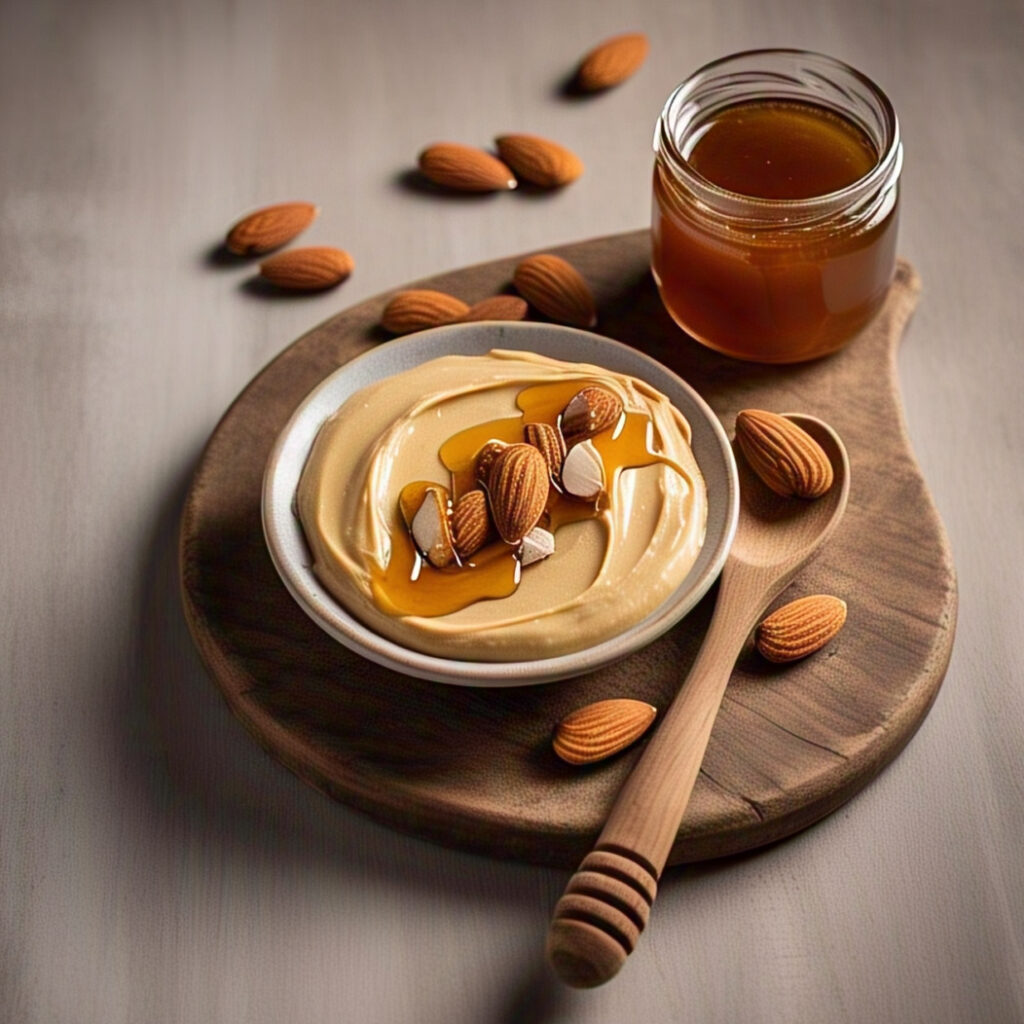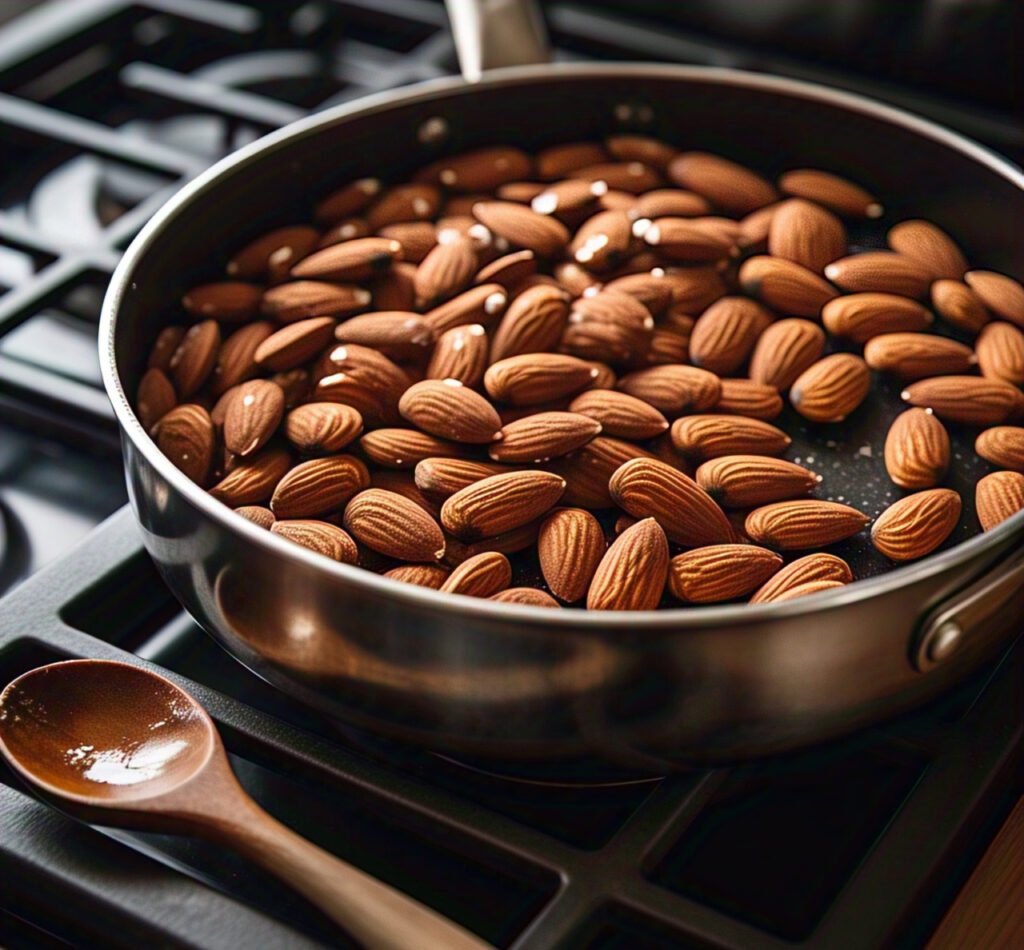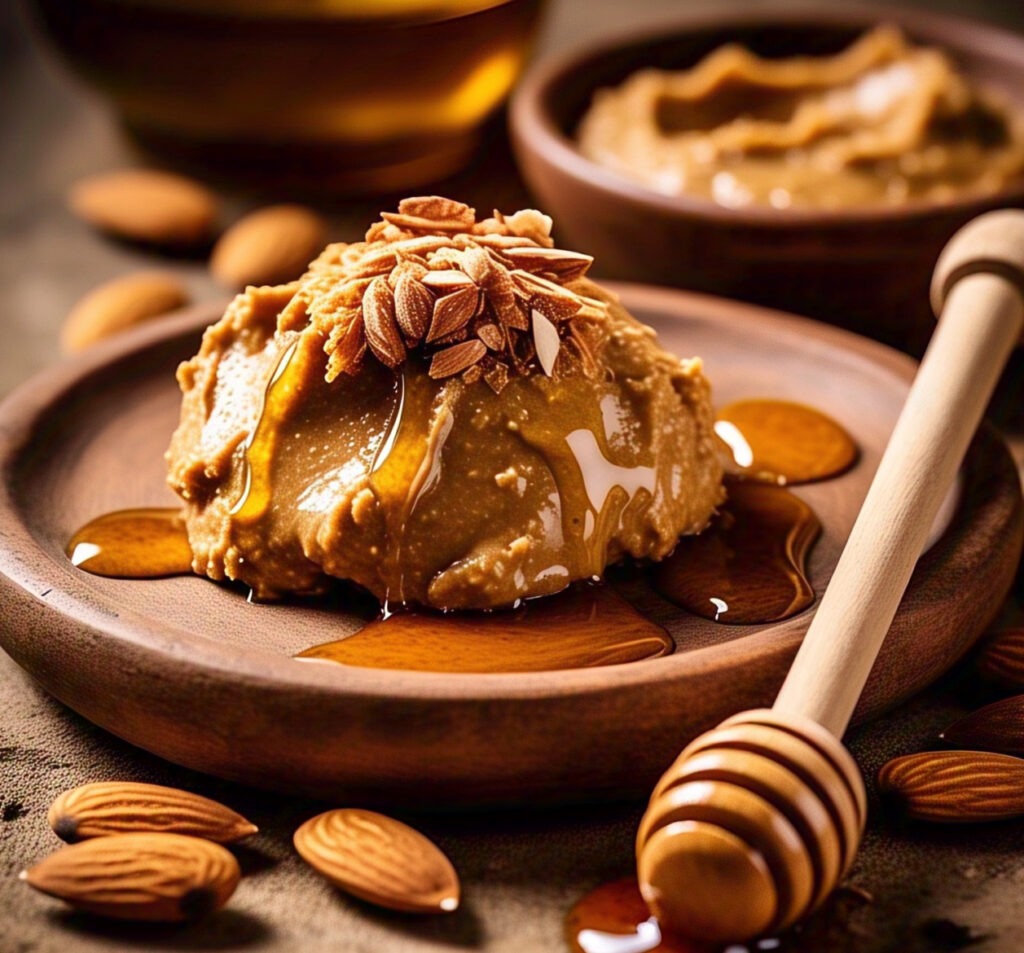Introduction
Amlou is a rich, nutty Moroccan spread made from roasted almonds, argan oil, and honey. Often referred to as the “Moroccan Nut Butter,” this delicious and nutritious paste is deeply rooted in Berber culture. It is traditionally enjoyed as a dip for bread or drizzled over breakfast foods like msemen (Moroccan pancakes).
What makes amlou unique is its use of culinary-grade argan oil, a rare and highly prized ingredient sourced from Morocco. This oil not only adds a distinct nutty flavor but also brings numerous health benefits, making amlou a true superfood.
Whether used as a spread, a drizzle, or a sweet topping, amlou is a flavorful and nutritious way to enjoy Moroccan culinary traditions.
The History and Cultural Significance of Amlou
Amlou is more than just a delicious Moroccan spread—it is deeply rooted in Berber traditions and Moroccan cuisine. This rich, nutty paste has been cherished for centuries, both as a nourishing food and a symbol of Moroccan hospitality.
Amlou in Moroccan Cuisine
Amlou originates from Morocco’s Berber communities, particularly in the southern regions of the country, where argan trees grow naturally. It has been a staple in Berber households for generations, often served as a breakfast spread or a treat for honored guests.
Traditional Uses of Amlou:
- Breakfast Staple: Spread over warm Moroccan msemen (flaky pancakes) or khobz (bread).
- Tea Time Treat: Served alongside Moroccan mint tea as a dip for bread.
- Special Occasions: Often prepared for weddings, family gatherings, and welcoming guests.
Amlou’s rich flavor and energy-boosting properties made it an ideal food for desert travelers and those engaging in physical labor, as it provides long-lasting nourishment.

The Role of Argan Oil in Amlou
One of the key ingredients in amlou is culinary argan oil, which comes from the kernels of the argan tree (Argania spinosa). The argan tree is native to Morocco, particularly in the Souss-Massa region, where it has been cultivated for centuries.
Why Argan Oil is Special:
- Nutty Flavor: Gives amlou its distinctive taste and smooth texture.
- Rare and Precious: It takes about 30 kilograms (66 lbs) of argan fruit to produce just 1 liter of oil.
- Nutritional Benefits: Rich in omega fatty acids, vitamin E, and antioxidants, making it excellent for heart health and skin care.
Historically, Berber women have been the custodians of argan oil production, using traditional hand-pressing methods to extract the oil. Today, many women’s cooperatives in Morocco continue this tradition, producing high-quality argan oil while supporting local communities.
Amlou vs. Other Nut Butters
While amlou is sometimes compared to peanut butter or almond butter, it has a more luxurious texture and a richer flavor due to the presence of pure argan oil and honey.
Amlou stands out because of its natural sweetness, health benefits, and authentic Moroccan heritage.
| Nut Butter | Key Ingredients | Unique Features |
|---|---|---|
| Amlou | Almonds, argan oil, honey | Rich, smooth, slightly runny texture with deep nutty flavor |
| Peanut Butter | Peanuts, vegetable oil, sugar | Thick and creamy, often processed |
| Almond Butter | Almonds, oil (sometimes added) | Similar base but lacks the unique flavor of argan oil |
| Hazelnut Spread | Hazelnuts, chocolate, sugar | Sweeter, often includes cocoa or chocolate |
Amlou is more than just food—it’s a piece of Moroccan culture, a symbol of warm hospitality, and a showcase of the country’s incredible natural ingredients. Whether enjoyed as a breakfast staple or a luxurious treat, amlou represents the richness of Moroccan traditions.
Ingredients Needed to Make Amlou
Amlou is made with just three simple ingredients, but the quality of each component is key to achieving its rich, nutty flavor and smooth texture. Below is a breakdown of the essential ingredients and what to look for when selecting them.
1. Almonds – The Heart of Amlou
Almonds form the base of amlou, providing a creamy texture and deep, roasted nutty flavor.
Best Type of Almonds:
- Raw, unpeeled almonds are ideal, as roasting them with their skins enhances the flavor.
- Organic or high-quality almonds are recommended to avoid additives or preservatives.
Why Roasting is Important:
- Brings out the natural oils, making the almonds blend more smoothly.
- Enhances the nutty aroma and flavor.
- Creates a richer, deeper color in the final spread.
Tip: Avoid pre-roasted or salted almonds, as they can alter the taste of amlou.
2. Argan Oil – The Liquid Gold of Morocco
Culinary argan oil gives amlou its signature smooth consistency and distinctive flavor. Unlike cosmetic argan oil, which is used for skin and hair, culinary argan oil is specially prepared for consumption.
What to Look For:
- 100% pure culinary argan oil (light golden color, nutty aroma).
- Cold-pressed for maximum nutrients and authentic flavor.
- Sourced from Moroccan cooperatives for ethical and high-quality production.
Health Benefits of Argan Oil:
- Rich in antioxidants and vitamin E – great for heart health and reducing inflammation.
- High in healthy fats – supports brain function and cholesterol balance.
Tip: Argan oil can be expensive, but it is the key to authentic amlou. If needed, a blend of argan and almond oil can be used as a substitute, though the taste will differ slightly.

3. Honey – The Natural Sweetener
Honey balances the richness of almonds and argan oil, adding natural sweetness and depth.
Best Type of Honey:
- Raw, unprocessed honey for maximum flavor and nutrients.
- Moroccan honey varieties (like thyme or orange blossom) provide authentic taste.
Why Honey is Important:
- Acts as a natural preservative, helping amlou last longer.
- Adds a smooth, slightly sticky texture that binds the ingredients.
- Complements the nutty and earthy tones of the spread.
Tip: If you prefer a vegan amlou, substitute honey with date syrup or maple syrup.
4. Ingredient Proportions for a Traditional Amlou Recipe
For 1 cup of amlou, you will need:
- 1 cup raw almonds (about 150g)
- ¼ to ½ cup argan oil (adjust for desired consistency)
- 3 tablespoons honey (adjust based on sweetness preference)
These three simple ingredients come together to create a delicious, nutrient-rich spread that is uniquely Moroccan.
How to Make Amlou (Step-by-Step Guide)
Making homemade amlou is easy, but achieving the perfect creamy, nutty texture requires the right technique. Follow these step-by-step instructions to create an authentic Moroccan almond and argan oil spread.
Ingredients for Homemade Amlou
For 1 cup of amlou, you will need:
1 cup raw almonds (about 150g)
¼ to ½ cup argan oil (adjust for consistency)
3 tablespoons honey (adjust for sweetness)
Optional Add-Ins:
- Pinch of salt (to enhance flavor)
- ½ teaspoon cinnamon (for a warm, spiced touch)
Step 1 – Roast the Almonds
Why This Step Matters:
Roasting enhances the almonds’ natural oils and gives amlou a deep, nutty flavor.
1️⃣ Preheat your oven to 350°F (175°C).
2️⃣ Spread raw almonds in a single layer on a baking sheet.
3️⃣ Roast for 10-12 minutes, stirring once halfway through.
4️⃣ Let the almonds cool slightly before blending.
Alternative: If you prefer, you can roast almonds in a dry pan over medium heat for 5-7 minutes, stirring constantly.

Step 2 – Blend the Almonds into a Paste
Key to Success:
Blend slowly and patiently to release the natural oils and create a smooth paste.
1️⃣ Place the roasted almonds in a food processor or high-speed blender.
2️⃣ Pulse in short bursts until the almonds break into small crumbs.
3️⃣ Blend continuously for 2-3 minutes until the mixture starts turning into a thick paste.
4️⃣ If needed, scrape down the sides to ensure even blending.
Pro Tip: If the mixture remains dry, add 1 tablespoon of argan oil at a time to help it blend smoothly.
Step 3 – Add Argan Oil and Honey
Achieving the Right Texture:
The amount of argan oil controls how thick or runny your amlou will be.
1️⃣ With the blender running, slowly drizzle in argan oil until the mixture turns creamy.
2️⃣ Add honey and blend again for 30 seconds until fully incorporated.
3️⃣ Taste and adjust by adding more honey for sweetness or more argan oil for a thinner consistency.
Final Texture Guide:
- Thicker Amlou → Use less oil for a peanut butter-like spread.
- Drizzling Amlou → Use more oil for a honey-like consistency, perfect for pouring over pancakes.

Step 4 – Store and Enjoy
- Transfer the amlou into a glass jar with an airtight lid.
- Store at room temperature for up to 2 weeks or refrigerate for 1 month.
- Stir before using if separation occurs.
Serving Ideas:
- Spread on warm bread, msemen, or toast.
- Drizzle over pancakes, waffles, or yogurt.
- Use as a dip for fruits or nuts.
Quick Troubleshooting Tips
Amlou is too thick?
✔ Add more argan oil 1 tablespoon at a time.
Not sweet enough?
✔ Mix in extra honey or a natural sweetener like date syrup.
The texture isn’t smooth?
✔ Keep blending—it takes time for almonds to release their oils.
With this easy homemade recipe, you can enjoy authentic Moroccan amlou anytime!
Tips for Perfect Amlou
Making authentic amlou requires a balance of the right ingredients and techniques. Here are expert tips to ensure your amlou turns out smooth, flavorful, and long-lasting.
1- Choosing High-Quality Ingredients
1️⃣ Use Fresh Almonds
- Stale almonds can make the amlou taste bitter. Always use fresh, raw almonds and roast them yourself for the best flavor.
2️⃣ Select Pure Argan Oil
- Only use culinary-grade argan oil (not cosmetic) for authentic taste and health benefits. Look for cold-pressed argan oil from Moroccan cooperatives.
3️⃣ Pick the Right Honey
- Raw, unprocessed honey gives the best sweetness and preserves nutrients. Moroccan thyme honey or orange blossom honey work beautifully.
2- Perfecting the Texture
- Blending is Key
- Patience is important—blend in stages to release the almonds’ natural oils.
- A food processor works best; blenders may need frequent pauses to prevent overheating.
2. Texture Adjustments
- For a thick, spreadable amlou: Use less argan oil and blend until creamy.
- For a thin, drizzling consistency: Add extra argan oil to make it pourable.
Pro Tip: If your amlou is too thick and dry, add 1 tablespoon of warm water and blend again.
3- Storage Tips for Freshness
- Keep Amlou in a Glass Jar
- Store amlou in an airtight glass jar to prevent oxidation and preserve flavor.
2. Shelf Life
- Room Temperature: 2 weeks (stir before use if separation occurs).
- Refrigerator: 1 month (bring to room temperature before serving).
3. Avoid Plastic Containers
- Argan oil is sensitive to plastic and can absorb unwanted flavors.
4- Common Mistakes to Avoid
- Using Low-Quality Oil
- Poor-quality or refined argan oil won’t have the nutty taste needed for authentic amlou.
2. Skipping the Roasting Step
- Raw almonds lack flavor—roasting deepens the taste and helps create a smoother consistency.
3. Overheating the Blender
- If the food processor overheats, the amlou can turn oily instead of creamy. Let it rest between blending stages.
4. Adding Too Much Honey at Once
- Too much honey can make amlou overly sticky. Add gradually and adjust to taste.
By following these tips, you’ll create smooth, delicious, and authentic Moroccan amlou every time!
Health Benefits of Amlou
Amlou isn’t just delicious—it’s also packed with nutrients, antioxidants, and healthy fats that offer numerous health benefits. Made with almonds, argan oil, and honey, this Moroccan superfood is a great addition to a balanced diet.
1. Rich in Healthy Fats
Argan oil is high in monounsaturated and polyunsaturated fats, which support heart health and help lower bad cholesterol (LDL) while raising good cholesterol (HDL).
Almonds also contain heart-friendly fats that reduce inflammation and improve circulation.
Why It Matters:
- Helps protect against heart disease.
- Aids in brain function and cognitive health.
2. Packed with Antioxidants
Vitamin E in almonds and argan oil acts as a powerful antioxidant, protecting the body from oxidative stress.
Honey is rich in polyphenols, which help fight free radicals and support the immune system.
Why It Matters:
- Slows aging and promotes healthy skin.
- Helps reduce inflammation and the risk of chronic diseases.

3. A Natural Energy Booster
Amlou is a high-energy food due to its combination of:
- Healthy fats from argan oil and almonds (long-lasting energy).
- Natural sugars from honey (quick energy boost).
Why It Matters:
- Keeps you full and energized for longer.
- Ideal for athletes, hikers, and people with active lifestyles.
Best Time to Eat Amlou: Breakfast or as a pre-workout snack.
4. Supports Digestive Health
Almonds are high in fiber, which aids digestion and promotes a healthy gut microbiome.
Honey has natural antibacterial properties, supporting gut health and soothing digestion.
Why It Matters:
- Prevents bloating and constipation.
- Supports a healthy metabolism.
5. Boosts the Immune System
Honey is a natural antimicrobial that helps fight infections.
Argan oil contains anti-inflammatory compounds that may strengthen the body’s defenses.
Why It Matters:
- Helps the body fight colds and flu.
- Aids in faster recovery from fatigue and illness.
6. Supports Skin and Hair Health
Argan oil is famous for its skin-nourishing properties. Even when consumed, it:
- Helps maintain hydrated and youthful skin.
- Strengthens hair and nails due to its high vitamin E content.
Almonds contain biotin and zinc, essential for stronger hair and glowing skin.
Why It Matters:
- Reduces dry skin and wrinkles.
- Promotes strong, shiny hair from within.
7. Naturally Gluten-Free and Dairy-Free
Amlou is perfect for people with dietary restrictions:
Gluten-Free – No wheat or grains.
Dairy-Free – No milk or butter.
Vegan-Friendly Option – Replace honey with date syrup or maple syrup.
Amlou is not just a delicious Moroccan delicacy, but also a nutrient-dense superfood with numerous health benefits. Whether eaten as a spread or a drizzle, it’s a natural and wholesome energy booster for any diet.
Nutritional benefits of almonds (Anchor: “Health benefits of almonds”).
Creative Ways to Use Amlou
Amlou is incredibly versatile, making it much more than just a breakfast spread. Whether you enjoy it drizzled, dipped, or mixed into other dishes, here are some creative ways to use amlou in both sweet and savory recipes.
1. Classic Moroccan Breakfast Spread
How to Use It:
- Spread on warm Moroccan msemen, baghrir, or khobz (Moroccan bread).
- Drizzle over toasted bread or croissants for a quick, nutritious breakfast.
Why It’s Great:
- Traditional and authentic Moroccan way to enjoy amlou.
- Keeps you full and energized for the day.
2. Drizzled Over Pancakes, Waffles, or Crepes
How to Use It:
- Instead of maple syrup, drizzle amlou over pancakes or waffles.
- Use as a sweet filling for crepes along with fresh fruits.
Why It’s Great:
- Adds a nutty, rich flavor.
- A healthy alternative to processed syrups.

3. Mixed into Smoothies and Shakes
How to Use It:
- Blend 1 tablespoon of amlou into your smoothie for an energy boost.
- Combine with bananas, almond milk, and cinnamon for a delicious shake.
Why It’s Great:
- Provides healthy fats, protein, and fiber.
- A perfect pre- or post-workout drink.
4. Topping for Yogurt or Oatmeal
How to Use It:
- Stir amlou into warm oatmeal for a nutty, creamy taste.
- Swirl amlou into Greek yogurt with chopped fruits.
Why It’s Great:
- Natural sweetness without refined sugars.
- Adds healthy fats and protein to your breakfast.
5. As a Dip for Fruits
How to Use It:
- Use amlou as a dip for apple slices, banana chunks, or strawberries.
- Drizzle over fruit salads for a Moroccan-inspired dessert.
Why It’s Great:
- A nutrient-dense snack for kids and adults.
- Perfect for parties or healthy snacking.
6. Amlou in Baking – Cookies and Muffins
How to Use It:
- Swap peanut butter for amlou in cookie or muffin recipes.
- Use amlou as a filling for pastries and cakes.
Why It’s Great:
- Adds a unique Moroccan twist to baked goods.
- Makes desserts naturally rich and moist.
7. Amlou as a Savory Ingredient
How to Use It:
- Drizzle over roasted vegetables for a nutty, slightly sweet contrast.
- Mix with lemon juice and spices for a Moroccan-style salad dressing.
- Serve with cheese and crackers as a sophisticated appetizer.
Why It’s Great:
- Works surprisingly well with savory dishes.
- Enhances salads, grilled meats, and cheese boards.
8. A Healthy Energy Snack
How to Use It:
- Spread amlou on rice cakes or crackers for a quick snack.
- Use as a dip for energy balls or granola bars.
Why It’s Great:
- Sustained energy from nuts, honey, and healthy fats.
- Great for pre-workout fuel or mid-day cravings.
Amlou is a deliciously versatile spread that can be enjoyed in countless ways beyond traditional Moroccan breakfasts. Whether you like it sweet, drizzled, or even savory, there’s always a new way to incorporate this superfood into your meals
Frequently Asked Questions About Amlou
Can I use a different type of nut instead of almonds?
Yes! While almonds are traditional, you can use:
- Hazelnuts – For a richer, Nutella-like flavor.
- Walnuts – Earthy and slightly bitter, pairs well with honey.
- Cashews – Creates a creamier and milder version of amlou.
Tip: Roasting the nuts before blending brings out the best flavor.
How long does homemade amlou last?
- At room temperature: 2 weeks in an airtight glass jar.
- In the refrigerator: Up to 1 month.
- In the freezer: Up to 3 months (thaw before use).
Tip: Stir before use if separation occurs (argan oil may rise to the top).
Can I make amlou without honey?
Yes! For a vegan amlou, replace honey with:
- Date syrup
- Maple syrup
- Agave nectar
Tip: If you prefer an unsweetened version, you can omit the sweetener entirely.
Can I use a regular blender instead of a food processor?
Yes, but a food processor works best because it:
- Handles thick almond paste more easily.
- Blends ingredients more evenly without overheating.
Tip: If using a blender, pulse in short bursts and scrape down the sides frequently.
Why is my amlou too thick or too runny?
- Too thick? Add more argan oil (1 tablespoon at a time).
- Too runny? Add more ground almonds and blend again.
Tip: The perfect consistency is spreadable but slightly drizzly.
Conclusion
Amlou is more than just a Moroccan spread—it’s a symbol of tradition, health, and indulgence. Whether enjoyed at breakfast, in desserts, or as a dip, this nutrient-rich superfood offers a delicious way to experience the flavors of Morocco.
Made from roasted almonds, pure argan oil, and raw honey, amlou is packed with healthy fats, antioxidants, and energy-boosting nutrients. It’s easy to make, incredibly versatile, and can be customized to fit any diet.
Now that you know how to make authentic amlou at home, why not try it yourself? Experiment with different nuts, drizzle it over your favorite foods, and enjoy a taste of Morocco in every bite!
Others Recipes to Try
Looking for citrus-inspired desserts? Check out these recipes:
- Citrus Mandarin Orange Cake Recipe: Discover another vibrant orange dessert that pairs citrus flavors with a moist and tender cake base.
- Chocolate Orange Cake Recipe: Explore a richer take on orange desserts by combining chocolate and orange for a sophisticated treat.
- Lemon and White Chocolate Cookies: Enjoy a citrusy twist on cookies with this sweet and tangy combination.


19 thoughts on “Amlou: The best Moroccan Almond and Argan Oil Spread Recipe”
Comments are closed.